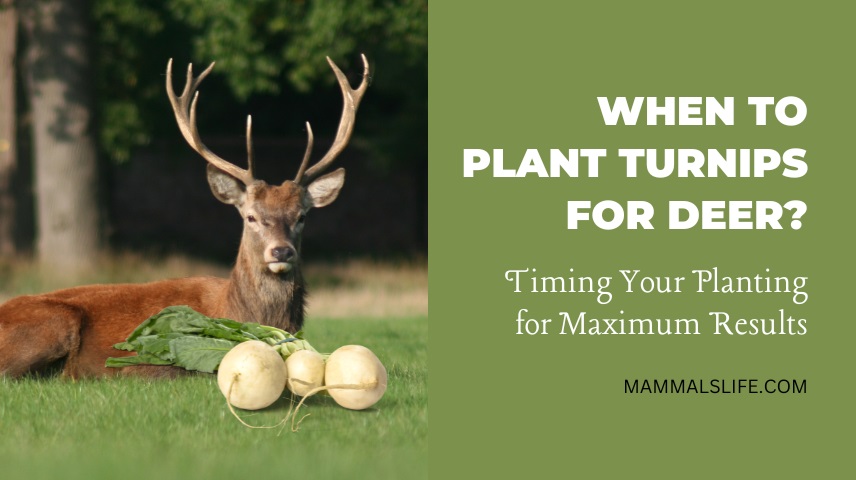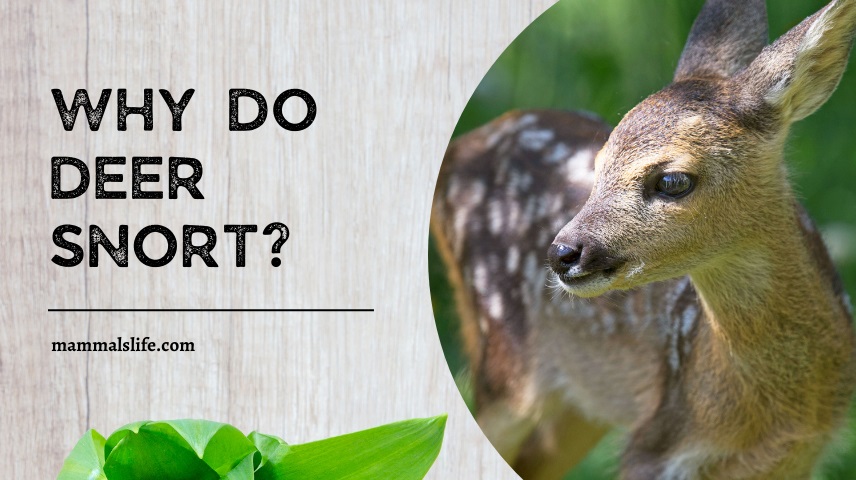Last Updated on February 22, 2025 by Mammals Life
Plant turnips for deer 60 to 90 days before the first expected frost. Late summer to early fall is ideal.
Turnips are a favorite among deer, offering nutritious forage during colder months. Planting turnips at the right time ensures maximum growth and attractiveness to deer. Late summer and early fall are the best times to plant turnips for optimal results.
This timing allows turnips to establish before frost, providing essential nutrients through winter. Deer benefit from the high-energy content of turnips, making them a valuable addition to food plots. Proper timing is crucial for turnip growth and deer attraction. Ensuring your planting aligns with these seasons can enhance your success in attracting and sustaining deer populations.
Ideal Planting Seasons
Planting turnips for deer involves selecting the right seasons. The timing ensures the best growth and nutrition. Turnips are resilient and can thrive in both spring and fall.
Spring Planting
Planting turnips in spring offers many benefits. The soil is warming up, and there is plenty of moisture. The ideal time to plant is after the last frost. This usually falls between March and May, depending on your location. Turnips need about 50-60 days to mature. This means deer will have fresh forage by late spring or early summer.
- Temperature: 50-75°F (10-24°C)
- Soil: Well-drained and fertile
- Water: Consistent moisture, but avoid waterlogging
Fall Planting
Fall is another excellent time to plant turnips for deer. The cooler temperatures help the plants grow steadily. Planting should occur 70-90 days before the first frost. This usually falls between August and September. Turnips planted in fall provide forage through winter.
- Temperature: 40-60°F (4-15°C)
- Soil: Well-drained and rich in organic matter
- Water: Regular watering, especially during dry spells
Here is a quick reference table for planting seasons:
| Season | Planting Month | Days to Maturity | Optimal Temperature |
|---|---|---|---|
| Spring | March-May | 50-60 days | 50-75°F (10-24°C) |
| Fall | August-September | 70-90 days | 40-60°F (4-15°C) |
Soil Preparation Tips
To achieve the best results when planting turnips for deer, proper soil preparation is essential. Healthy soil ensures that your turnips grow strong and nutritious, attracting deer to your food plot. Follow these soil preparation tips to maximize your planting success.
Soil Testing
Start with a soil test. This helps you understand your soil’s nutrient levels and pH balance. You can get a soil test kit from a gardening store or contact your local agricultural extension office.
After collecting your soil sample, send it to a lab for analysis. The results will tell you what nutrients are lacking and what amendments are needed.
Amendments
Based on your soil test results, you can add the necessary amendments to improve soil quality. Common amendments include:
- Lime: Raises soil pH if it’s too acidic. Turnips prefer a pH of 6.0 to 6.5.
- Compost: Adds organic matter, improving soil structure and fertility.
- Fertilizers: Provide essential nutrients like nitrogen, phosphorus, and potassium.
Incorporate these amendments into the soil by tilling or turning over the soil. This ensures that nutrients are evenly distributed and reach the root zone.
Proper soil preparation sets the stage for healthy turnip growth. Healthy turnips attract more deer to your plot, enhancing your hunting experience.
Choosing The Right Turnip Varieties
Choosing the right turnip varieties is crucial for attracting deer to your food plot. Different turnip types offer various benefits. Some are better for forage, while others serve dual purposes. Selecting the appropriate variety can maximize your results and keep deer coming back.
Forage Turnips
Forage turnips are specially bred for their lush, leafy tops. These tops are highly palatable and nutritious for deer. Forage turnips grow quickly and are often more cold-tolerant. They stay edible longer into the season, making them a reliable food source.
| Variety | Growth Rate | Cold Tolerance | Leaf Quality |
|---|---|---|---|
| Appin | Fast | High | Excellent |
| Barkant | Medium | Medium | Good |
Dual-purpose Turnips
Dual-purpose turnips provide both leafy tops and nutritious roots. Deer can eat the tops in the early season and the roots later. This variety ensures a continuous food source throughout the hunting season. Dual-purpose turnips are versatile and resilient.
| Variety | Top Quality | Root Quality | Season Length |
|---|---|---|---|
| Purple Top White Globe | Good | Excellent | Long |
| Seven Top | Excellent | Good | Medium |
Planting Methods
Understanding the best planting methods for turnips can maximize your success. Each method has its benefits and considerations. Let’s explore the two most common methods: Direct Seeding and Broadcast Seeding.
Direct Seeding
Direct seeding involves planting turnip seeds directly into the soil. This method ensures that each seed gets the best chance to grow.
- Prepare the soil by tilling it to a depth of 6 inches.
- Create furrows that are 1/2 inch deep.
- Space the seeds 2-4 inches apart in the furrows.
- Cover the seeds lightly with the soil.
- Water the area gently to keep it moist.
Direct seeding is best for small plots. This method allows for precise seed placement.
Broadcast Seeding
Broadcast seeding involves scattering turnip seeds over a large area. This method is efficient for large plots or fields.
- Tilling the soil is essential before scattering seeds.
- Mix the seeds with sand for even distribution.
- Scatter the seed-sand mixture evenly over the area.
- Use a rake to cover the seeds lightly with soil.
- Ensure the area receives adequate water.
Broadcast seeding is faster than direct seeding. It covers more ground quickly.
Both methods have their advantages and can lead to successful growth. Choose the method that best fits your needs and plot size.
Watering And Maintenance
Proper watering and maintenance are crucial for healthy turnip growth. Ensuring your turnips receive adequate water and care will help attract more deer. Below are some essential tips on irrigation and weed control.
Irrigation Tips
Turnips require consistent moisture to grow well. Here are some irrigation tips for optimal growth:
- Water turnips early in the morning to reduce evaporation.
- Ensure the soil remains moist, and not waterlogged.
- Use a soaker hose or drip irrigation for efficient watering.
- Monitor rainfall and adjust watering accordingly.
- Water deeply but less frequently to encourage root growth.
Regular watering helps turnips grow strong and healthy. This, in turn, attracts more deer to your plot.
Weed Control
Weeds compete with turnips for nutrients and water. Effective weed control ensures your turnips thrive:
- Remove weeds by hand or use a hoe.
- Apply mulch to suppress weed growth.
- Consider using a pre-emergent herbicide before planting.
- Regularly inspect your plot for new weeds.
- Keep the area around turnips clean and free from debris.
Effective weed control is essential for maximizing turnip growth. Healthy turnips are more attractive to deer.
Monitoring Growth And Harvest
Monitoring the growth and harvest of turnips is crucial for attracting deer. Proper timing ensures maximum yield and optimal nutrition for wildlife. This section provides insights into the growth stages and the best time to harvest turnips.
Growth Stages
Turnips go through several growth stages, each critical for development. Understanding these stages helps in planning your planting schedule.
- Germination: This stage lasts for 5-10 days. Seeds sprout and develop roots.
- Seedling Stage: This lasts for about 2-4 weeks. Small leaves start to appear.
- Vegetative Growth: This stage lasts 4-6 weeks. Plants develop more leaves and grow rapidly.
- Root Development: This is the final stage. Turnips grow large roots, suitable for deer.
Optimal Harvest Time
Determining the optimal harvest time is key for maximum nutrition. Turnips are usually ready to harvest 60-90 days after planting. Here are some indicators:
- Roots should be 2-3 inches in diameter.
- Leaves should be lush and green.
- Check for firmness and size consistency.
Harvesting at the right time ensures the best yield for feeding deer. Keep these factors in mind for a successful planting season.
Frequently Asked Questions
When Should I Plant Turnips For Deer?
Plant turnips for deer in late summer or early fall. Ensure soil temperatures are between 50-65°F.
What Is The Best Month To Plant Turnips?
The best month to plant turnips is August. Turnips thrive in cool weather and mature before frost. For a spring harvest, plant in early April.
What Is The Secret To Growing Turnips?
Plant turnips in well-drained soil with full sun. Water consistently and thin seedlings to ensure proper growth. Harvest when roots are 2-3 inches.
Can You Plant Turnips Without Tilling?
Yes, you can plant turnips without tilling. Use a no-till gardening method. Clear debris, add compost and plant seeds.
When Is The Best Time To Plant Turnips?
Plant turnips in late summer or early fall for optimal growth.
How Long Do Turnips Take To Grow?
Turnips typically mature in 30 to 60 days.
Conclusion
Timing your turnip planting is crucial for attracting deer. Plant in late summer or early fall for best results. This ensures turnips grow before frost, providing a nutritious food source. Proper timing maximizes your efforts and benefits local wildlife. Happy planting and enjoy watching the deer thrive!











